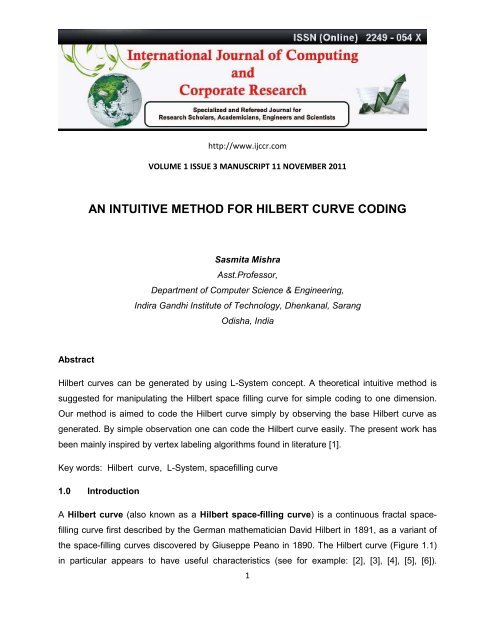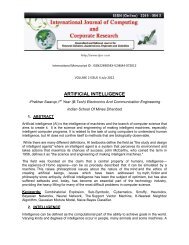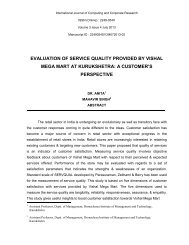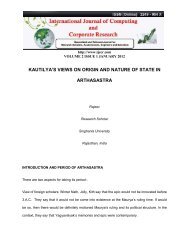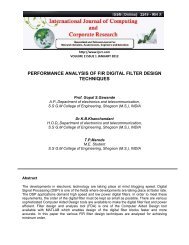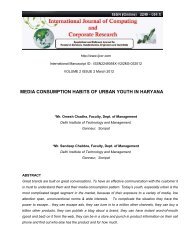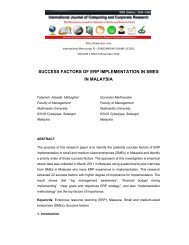Volume 1 issue 3 manuscript 11 november 2011 an - Ijccr.com
Volume 1 issue 3 manuscript 11 november 2011 an - Ijccr.com
Volume 1 issue 3 manuscript 11 november 2011 an - Ijccr.com
Create successful ePaper yourself
Turn your PDF publications into a flip-book with our unique Google optimized e-Paper software.
http://www.ijccr.<strong>com</strong><br />
VOLUME 1 ISSUE 3 MANUSCRIPT <strong>11</strong> NOVEMBER 20<strong>11</strong><br />
AN INTUITIVE METHOD FOR HILBERT CURVE CODING<br />
Sasmita Mishra<br />
Asst.Professor,<br />
Department of Computer Science & Engineering,<br />
Indira G<strong>an</strong>dhi Institute of Technology, Dhenk<strong>an</strong>al, Sar<strong>an</strong>g<br />
Odisha, India<br />
Abstract<br />
Hilbert curves c<strong>an</strong> be generated by using L-System concept. A theoretical intuitive method is<br />
suggested for m<strong>an</strong>ipulating the Hilbert space filling curve for simple coding to one dimension.<br />
Our method is aimed to code the Hilbert curve simply by observing the base Hilbert curve as<br />
generated. By simple observation one c<strong>an</strong> code the Hilbert curve easily. The present work has<br />
been mainly inspired by vertex labeling algorithms found in literature [1].<br />
Key words: Hilbert curve, L-System, spacefilling curve<br />
1.0 Introduction<br />
A Hilbert curve (also known as a Hilbert space-filling curve) is a continuous fractal spacefilling<br />
curve first described by the Germ<strong>an</strong> mathematici<strong>an</strong> David Hilbert in 1891, as a vari<strong>an</strong>t of<br />
the space-filling curves discovered by Giuseppe Pe<strong>an</strong>o in 1890. The Hilbert curve (Figure 1.1)<br />
in particular appears to have useful characteristics (see for example: [2], [3], [4], [5], [6]).<br />
1
http://www.ijccr.<strong>com</strong><br />
VOLUME 1 ISSUE 3 MANUSCRIPT <strong>11</strong> NOVEMBER 20<strong>11</strong><br />
However, it is widely considered to be tricky to work with. Abel <strong>an</strong>d Mark [2] found the Hilbert<br />
ordering to be very promising <strong>com</strong>pared with a number of other orderings in certain application<br />
domains, but the major weakness remains the lack of inexpensive algorithms to evaluate the<br />
key of a cell or sub quadr<strong>an</strong>t from its coordinates <strong>an</strong>d vice versa. Nulty [17], working with<br />
geometric r<strong>an</strong>ge searching problems, noted that the Hilbert curve has excellent clustering<br />
properties, but found it less convenient th<strong>an</strong> the N-Curve or the Sierpinski curve. Laurini <strong>an</strong>d<br />
Thompson [8] found the Hilbert <strong>an</strong>d Pe<strong>an</strong>o curves to be \more robust that is better performers<br />
over a r<strong>an</strong>ge of requirements, in spatial information systems. But, in the case of the Hilbert<br />
curve, it is quite <strong>com</strong>plex to get keys. The sequence of recursive Hilbert curves was discovered<br />
by the mathematici<strong>an</strong> David Hilbert about 100 years ago in order to <strong>an</strong>swer the Space Filling<br />
Curves Problem. In its simplest version, this problem asks if there exists a continuous function<br />
from the unit interval [0, 1] that maps onto the unit square in the pl<strong>an</strong>e. The <strong>an</strong>swer is yes <strong>an</strong>d<br />
the sequence of Hilbert curves gives a constructive definition of the function. To obtain the<br />
function, one must “pass to the limit” as the level N of recursion goes to infinity. Hilbert curves<br />
became well known in the <strong>com</strong>puter science <strong>com</strong>munity because Nicklaus Wirth used them as a<br />
key example of recursion in his fundamental text [2].<br />
Because it is space-filling, its Hausdorff dimension is 2 (precisely, its image is the unit square,<br />
whose dimension is 2 in <strong>an</strong>y definition of dimension; its graph is a <strong>com</strong>pact set homeomorphic<br />
to the closed unit interval, with Hausdorff dimension 2). H n is the nth approximation to the<br />
limiting curve. The Euclide<strong>an</strong> length of H n , i.e., it grows exponentially with n, while at the same<br />
time always being bounded by a square with a finite area.<br />
2
http://www.ijccr.<strong>com</strong><br />
VOLUME 1 ISSUE 3 MANUSCRIPT <strong>11</strong> NOVEMBER 20<strong>11</strong><br />
Certain space filling curves may not be given adequate attention, because of perceived difficulty<br />
or simply unfamiliarity. Indeed, empirical evidence suggests that researchers do tend to stick<br />
with the few well-known curves.<br />
1.1 Generation of Hilbert curve using L-System<br />
In this present paper the following Hilbert curve has been generated for using L-System strings<br />
[22] which have been taken as base curve for coding throughout the paper. The orientation is<br />
slightly different th<strong>an</strong> the curve as mentioned in the paper “Vertex Labeling Algorithm….” as<br />
suggested by Bartholdi <strong>an</strong>d Goldsm<strong>an</strong> [1]. The initial curve is drawn from the leftmost corner as<br />
shown in Figure 1.1 in iteration 1.<br />
Iteration 1 Iteration 2 Iteration 3<br />
3
http://www.ijccr.<strong>com</strong><br />
VOLUME 1 ISSUE 3 MANUSCRIPT <strong>11</strong> NOVEMBER 20<strong>11</strong><br />
Iteration 4 Iteration 5 Iteration 6<br />
hilbert curve{<br />
DIRS=4<br />
AXIOM=X<br />
X=-YF+XFX+FY-<br />
Y=+XF-YFY-FX+ }<br />
Figure 1.1: Generation of Hilbert curve using L-System concept<br />
The Hilbert curve as shown in Figure 1.1 has been generated by using the L-system concept up<br />
to 6 th iterations. The simple logical sequence of Hilbert curve is also shown in Figure 1.2. Hilbert<br />
curve is a space filling curve <strong>an</strong>d its import<strong>an</strong>ce has been increased in recent years due to its<br />
pretty simple representations <strong>an</strong>d their practical applications. Both the true Hilbert curve <strong>an</strong>d its<br />
discrete approximations are useful because they give a mapping between 1D <strong>an</strong>d 2D space that<br />
fairly well preserves locality [7],[8]. If (x,y) is the coordinates of a point within the unit square,<br />
<strong>an</strong>d d is the dist<strong>an</strong>ce along the curve when it reaches that point, then points that have nearby d<br />
4
http://www.ijccr.<strong>com</strong><br />
VOLUME 1 ISSUE 3 MANUSCRIPT <strong>11</strong> NOVEMBER 20<strong>11</strong><br />
values will also have nearby (x,y) values. The converse c<strong>an</strong>'t always be true. There will<br />
sometimes be points where the (x,y) coordinates are close but their d values are far apart. This<br />
is inevitable when mapping from a 2D space to a 1D space. But the Hilbert curve does a good<br />
job of keeping those d values close together much of the time. So the mappings in both<br />
directions do a fairly good job of maintaining locality.<br />
Because of this locality property, the Hilbert curve is widely used in <strong>com</strong>puter science. For<br />
multidimensional databases, Hilbert order has been proposed to be used instead of Z order<br />
because it has better locality-preserving behavior [8]-[<strong>11</strong>]. Given the variety of applications, it is<br />
useful to have algorithms to map in both directions.<br />
Figure 1.2: Generation of Hilbert Curve in simple steps<br />
We offer a new approach, based on vertex-coding, for generating algorithms for the Hilbert<br />
curve. This approach leads to simple procedures that involve no <strong>com</strong>plex mathematical or<br />
geometric operations. These procedures are also quite flexible. This is import<strong>an</strong>t since m<strong>an</strong>y<br />
<strong>com</strong>mon geometric models are <strong>com</strong>posed of irregular figures.<br />
5
http://www.ijccr.<strong>com</strong><br />
VOLUME 1 ISSUE 3 MANUSCRIPT <strong>11</strong> NOVEMBER 20<strong>11</strong><br />
2.0 Org<strong>an</strong>ization of the paper<br />
This paper is org<strong>an</strong>ised as follows.<br />
The Section 1.0 discusses briefly about the concept behind Hilbert curve <strong>an</strong>d highlights some of<br />
practical application area in the field of <strong>com</strong>puter science particularly in database. Section 1.1<br />
elaborates simple method to generate Hilbert curve. The next section puts forth the survey<br />
about the work done so far to find out the motivation <strong>an</strong>d objective. Section 4 <strong>com</strong>prehensibly<br />
discusses about the proposed indexing method in a lucid m<strong>an</strong>ner. The finally Section 5.0<br />
concludes with future scope.<br />
3.0 Survey<br />
This survey aims at summarizing the literature relev<strong>an</strong>t to R-trees. Space filling curves,<br />
functions that continuously map the unit interval on to a bounded region of higher dimension,<br />
have stimulated increasing interest in recent years due to their pretty representations <strong>an</strong>d their<br />
use in practical applications [5], [17].The Hilbert R-tree is a hybrid structure based on R-trees<br />
<strong>an</strong>d B+-trees [14]-[20]. Actually, it is a B+-tree with geometrical objects being characterized by<br />
the Hilbert value of their centroid. Thus, leaves <strong>an</strong>d internal nodes are augmented by the largest<br />
Hilbert value of their contained objects or their descend<strong>an</strong>ts, respectively. For <strong>an</strong> insertion of a<br />
new object, at each level the Hilbert values of the alternative nodes are checked <strong>an</strong>d the<br />
smallest one that is larger th<strong>an</strong> the Hilbert value of the object under insertion is followed. In<br />
addition, <strong>an</strong>other heuristic used in case of overflow by Hilbert R-trees is the redistribution of<br />
objects in sibling nodes. In other words, in such a case up to s siblings are checked in order to<br />
find available space <strong>an</strong>d absorb the new object. A split takes place only if all s siblings are full<br />
<strong>an</strong>d, thus, s+1 nodes are produced. This heuristic is similar to that applied in B*-trees, where<br />
6
http://www.ijccr.<strong>com</strong><br />
VOLUME 1 ISSUE 3 MANUSCRIPT <strong>11</strong> NOVEMBER 20<strong>11</strong><br />
redistribution <strong>an</strong>d 2-to-3 splits are performed during node overflows [18],[12],[21]. According to<br />
the authors’ experimentation, Hilbert R-trees were proven to be the best dynamic version of R-<br />
trees as of the time of publication. However, this vari<strong>an</strong>t is vulnerable perform<strong>an</strong>ce-wise to large<br />
objects.<br />
4.0 Motivation<br />
The present research is aimed at query processing <strong>an</strong>d <strong>com</strong>pression of large database system.<br />
Particularly the resulted techniques may be used in r<strong>an</strong>ge query processing <strong>an</strong>d <strong>com</strong>pression in<br />
the tele<strong>com</strong> sector databases to reduce the disk spaces. In this paper <strong>an</strong> easier method is<br />
suggested for coding of Hilbert spacefilling curve without mathematical <strong>com</strong>plexities.<br />
4.1 Suggested Intuitive Approach<br />
Figure 1.2 shows <strong>an</strong> alternate way to illustrate the Hilbert curve, in which the line segments of<br />
Figure 1.1 have been replaced by arcs. This is slightly different th<strong>an</strong> the idea given in the paper<br />
found from literature [1]. The arc notation conveys more information, since it (broadly) indicates<br />
how space is ordered within each cell. Loosely speaking, the arcs are me<strong>an</strong>t to show that the<br />
curve enters each cell at a vertex, visits every point in the cell, exits at a different vertex, then<br />
enters the next cell <strong>an</strong>d so on.<br />
7
http://www.ijccr.<strong>com</strong><br />
VOLUME 1 ISSUE 3 MANUSCRIPT <strong>11</strong> NOVEMBER 20<strong>11</strong><br />
Figure 4.1: The Hilbert space filling curve<br />
One observes immediately the self-similar nature of such curves: Each level of the curve is<br />
<strong>com</strong>posed of multiple, smaller copies of previous levels, oriented in various ways. Components<br />
of a curve exp<strong>an</strong>d in a predictable way to multiple <strong>com</strong>ponents at the next level. For example, in<br />
the curve illustrated, it is easy to see that each arc exp<strong>an</strong>ds into four connected arcs. Most<br />
space filling curve algorithms are based on a geometric <strong>an</strong>alysis of how the shapes exp<strong>an</strong>d at<br />
each level. Our approach is more topological, more concerned with how the curve relates sub<br />
cells of a cell to each other.<br />
8
http://www.ijccr.<strong>com</strong><br />
VOLUME 1 ISSUE 3 MANUSCRIPT <strong>11</strong> NOVEMBER 20<strong>11</strong><br />
Figure 4.2: Level 1 <strong>an</strong>d 2 Hilbert codes<br />
Each cell at the same level of the de<strong>com</strong>position is equivalent in size <strong>an</strong>d shape <strong>an</strong>d has a preimage<br />
in R 1 consisting of <strong>an</strong> equal-size subinterval of the unit interval. For example, Level 1 of<br />
the de<strong>com</strong>position has four cells, whose pre-images are: [0.0, 0.1], [0.1, 0.2], [0.2, 0.3], <strong>an</strong>d [0.3,<br />
1.0] (in base 4). One c<strong>an</strong> follow a <strong>com</strong>mon convention <strong>an</strong>d assign the lower bound of each<br />
interval as the index value or Hilbert code of the corresponding cell. Thus, the four cells of Level<br />
1 have codes of 0.0, 0.1, 0.2, <strong>an</strong>d 0.3, respectively (Figure 3). We refer to codes as index<br />
values since they c<strong>an</strong> be sorted to order the cells. Such <strong>an</strong> ordering is continuous, due to the<br />
continuity of space filling curves. Cells adjacent in the ordering are adjacent in space; cells near<br />
in space tend to be near in the ordering. The curve imposes <strong>an</strong> order on points located in cells<br />
in the following way: A point assumes the Hilbert code of its (smallest) enclosing cell. In other<br />
words, points are ordered according to the sequence in which the curve visits their cells.<br />
Therefore, if we w<strong>an</strong>t to sort a set of points according to the curve, we need to find a<br />
9
http://www.ijccr.<strong>com</strong><br />
VOLUME 1 ISSUE 3 MANUSCRIPT <strong>11</strong> NOVEMBER 20<strong>11</strong><br />
de<strong>com</strong>position in which each point is located in a different cell, <strong>an</strong>d then the ordering of the<br />
points is established by their Hilbert codes.<br />
We convert from a point in R 2 , to its Hilbert code (in R 1 ), at a given precision, by finding a<br />
sufficiently small cell enclosing the point. We are indifferent to the exact position of the point<br />
within the cell. If we later w<strong>an</strong>t to recover the coordinates of a point, we will have to choose<br />
some point within the enclosing region. With care, this c<strong>an</strong> be performed multiple times without<br />
loss of precision.<br />
a<br />
d<br />
0.0 0.3<br />
a b c d<br />
0.<br />
d c b 0.3 a<br />
0.0<br />
a d a d<br />
b<br />
c<br />
0.1 0.2<br />
b 0.1 c b 0.2 c<br />
Level 1 Level 2<br />
Figure 4.3. Correspondence between vertex labels <strong>an</strong>d arcs<br />
4.2 Proposed Procedure<br />
The Hilbert curve orders the space within each cell in such a way that the lowest point occurs at<br />
one entry vertex, <strong>an</strong>d the highest occurs at a different exit vertex. The arcs in the direction of<br />
arrow, in Figure 4.1 indicate this ordering by beginning at one vertex <strong>an</strong>d ending at <strong>an</strong>other<br />
vertex. Each time the cell is divided, the spatial ordering is refined to a greater level of detail.<br />
10
http://www.ijccr.<strong>com</strong><br />
VOLUME 1 ISSUE 3 MANUSCRIPT <strong>11</strong> NOVEMBER 20<strong>11</strong><br />
Our approach encodes cell vertices in sequence, to indicate the order in which regions of the<br />
cell are visited by the curve. The vertex where the curve enters the cell is labeled ‘a’. The vertex<br />
where the curve exits the cell is labeled ‘d’. The intermediate vertices are labeled, in order, ‘b’<br />
<strong>an</strong>d ‘c’.<br />
The curve notation is a kind of shorth<strong>an</strong>d for the vertex labels. Figure 4.3 shows how the<br />
systems correspond. The arc notation is more visually appealing <strong>an</strong>d reveals the spatial<br />
ordering at a gl<strong>an</strong>ce. In addition to its vertex labels, each cell has a base 4 Hilbert code between<br />
0 <strong>an</strong>d 1 indicating its place in the cell ordering. An observation now leads us to the labeling<br />
approach to space filling curve algorithms referring to nothing more th<strong>an</strong> the Hilbert codes <strong>an</strong>d<br />
vertex information (labels <strong>an</strong>d coordinates) of a cell; we c<strong>an</strong> generate the Hilbert codes <strong>an</strong>d<br />
vertex information of all of its sub cells.<br />
The labeling process is summarized in Figure 5. At the top level, the Hilbert code is initialized to<br />
`0:', <strong>an</strong>d the vertices are labeled. At the next level, the square region is divided into four<br />
equivalent square sub cells. The Hilbert code of each cell is updated by right-appending a digit<br />
as follows: `0' for the cell containing vertex a; `1' for the cell containing vertex b; `2' for the cell<br />
containing vertex c; `3' for the cell containing vertex d.<br />
The new vertices are labeled in accord<strong>an</strong>ce with the basic Hilbert curve flow pattern. It is<br />
very helpful to refer to the arc diagrams in determining the details of vertex relabeling. As <strong>an</strong><br />
example, we examine how the vertices in cell 0.0 (containing vertex a) are updated. Recall that<br />
<strong>an</strong> arc enters a cell at vertex a, exits at vertex d, <strong>an</strong>d the remaining vertices are labeled, in<br />
sequence, c <strong>an</strong>d d. We refer to the vertices of cell 0.0 as: a new , b new , c new , <strong>an</strong>d d new . By<br />
observation (Figure 5), the arc enters cell 0.0 at vertex a, <strong>an</strong>d exits at a vertex on the midpoint<br />
<strong>11</strong>
http://www.ijccr.<strong>com</strong><br />
VOLUME 1 ISSUE 3 MANUSCRIPT <strong>11</strong> NOVEMBER 20<strong>11</strong><br />
of edge (a, b). Following the curve in sequence, vertex b new is located at the midpoint of edge<br />
(a,d), <strong>an</strong>d vertex c new is at the midpoint of edge (a; c). This leads to the following update rules for<br />
cell 0.0.<br />
a<br />
b<br />
0.0<br />
d<br />
c<br />
a<br />
b<br />
0.0 0.3<br />
0.1 0.2<br />
d<br />
c<br />
a b c d<br />
0.0 0.3<br />
d c b a<br />
a d a d<br />
0.1 0.2<br />
b c b c<br />
a<br />
b<br />
d<br />
c<br />
Figure 4.4: Hilbert curve label updating<br />
By observation (Figure 4.4), the arc enters cell 0:0 at vertex a, <strong>an</strong>d exits at a vertex on the<br />
midpoint of edge (a, b). Following the curve in sequence, vertex b new is located at the midpoint<br />
of edge (a,d), <strong>an</strong>d vertex c new is at the midpoint of edge (a, c). This leads to the following update<br />
rules for cell 0.0:<br />
a new = a<br />
b new = (a + d) / 2<br />
c new = (a + c) / 2<br />
d new = (a + b) / 2<br />
12
http://www.ijccr.<strong>com</strong><br />
VOLUME 1 ISSUE 3 MANUSCRIPT <strong>11</strong> NOVEMBER 20<strong>11</strong><br />
Cells 0.1, 0.2 <strong>an</strong>d 0.3 are updated in a similar way; their relabeling rules c<strong>an</strong> be read directly<br />
from the diagram.<br />
Cell 0.1:<br />
a new = (a + b) / 2<br />
b new = b<br />
c new = (b + c)/2<br />
d new = (b + d)/2<br />
Cell 0.2:<br />
Cell 0:3:<br />
a new = (a + c)/2<br />
b new = (b + c)/2<br />
c new = c<br />
d new = (c + d)/2<br />
a new = (d + c)/2<br />
b new = (b + d)/2<br />
c new = (d + a)/2<br />
d new = d<br />
13
http://www.ijccr.<strong>com</strong><br />
VOLUME 1 ISSUE 3 MANUSCRIPT <strong>11</strong> NOVEMBER 20<strong>11</strong><br />
From the observations above one c<strong>an</strong> visit <strong>an</strong>d code the Hilbert curve by looking at the curve<br />
pattern. One c<strong>an</strong> confirm the coding by superimposing the generated Hilbert curve with m<strong>an</strong>ual<br />
drawing of quadr<strong>an</strong>ts.<br />
.000 .003 .030 .031<br />
.001 .002 .031 .032 0.3<br />
.012 .0<strong>11</strong> .020 .021<br />
.013 .010 .022 .023<br />
0.1 0.2<br />
Figure 4.5 : Super imposing of Hilbert curve in L-System <strong>an</strong>d m<strong>an</strong>ual quadr<strong>an</strong>t<br />
14
http://www.ijccr.<strong>com</strong><br />
VOLUME 1 ISSUE 3 MANUSCRIPT <strong>11</strong> NOVEMBER 20<strong>11</strong><br />
The above Figure 4.5 c<strong>an</strong> directly be used for coding of curves. The topmost left corner cell is<br />
coded as .000. The first quadr<strong>an</strong>t has been coded <strong>an</strong>d has been shown in the Figure 4.5<br />
4.3 Summary of Hilbert curve labeling procedure<br />
Step 1: Initialization.<br />
We initialize the vertex labels of a square bounding region, so that the entry vertex of <strong>an</strong> arc is<br />
labeled a, the exit vertex is labeled d, <strong>an</strong>d the intermediate vertices are labeled in order b <strong>an</strong>d c.<br />
We assign Hilbert code '0.' to the region (Figure 4.4).<br />
Step 2: Iterative step, I: Finding Hilbert codes of sub cells.<br />
To create the next level of the de<strong>com</strong>position, we divide the square into four sub squares, by<br />
adding one edge from the midpoint of edge (a, b) to the midpoint of edge (c, d), <strong>an</strong>d <strong>an</strong>other<br />
edge from the midpoint of edge (b, c) to the midpoint of edge (a,d). We first update the codes of<br />
each of the four subcells as follows. The subcell containing vertex a is the first visited by the<br />
curve, so we right-append the digit '0' to the code of its supercell. Following the path of the<br />
curve, we right-append the digit '1' for the subcell containing vertex b, '2' for the subcell<br />
containing c, <strong>an</strong>d '3' for the subcell containing d.<br />
Step 3: Iterative step, II: relabeling vertices of subcells.<br />
Each arc exp<strong>an</strong>ds into four arcs, one in each new subcell; we relabel vertices in such a way that<br />
each new arc progresses from vertex a to d within its cell, with the intermediate vertices labeled,<br />
in order, b <strong>an</strong>d c. Vertices already labeled a, b, c <strong>an</strong>d d do not ch<strong>an</strong>ge. The thirteen new<br />
vertices<br />
are labeled as detailed above (<strong>an</strong>d in the figure).<br />
15
http://www.ijccr.<strong>com</strong><br />
VOLUME 1 ISSUE 3 MANUSCRIPT <strong>11</strong> NOVEMBER 20<strong>11</strong><br />
Step 4: Finalization.<br />
Continue the iteration steps until sufficient precision is reached.<br />
Therefore, given initial vertex information <strong>an</strong>d index value of a square region, creating iterates of<br />
de<strong>com</strong>position according to the Hilbert curve is a purely mech<strong>an</strong>ical process. It c<strong>an</strong> proceed<br />
with no additional information, <strong>an</strong>d no need to further <strong>an</strong>alyze the geometry. By recursively<br />
applying this procedure, we may label cells of the de<strong>com</strong>position to <strong>an</strong>y depth.<br />
4.4 Computing a pre-image of a point in R 2<br />
We wish to convert from a point in a square bounding region to its corresponding Hilbert code. A<br />
point located in a square region takes the Hilbert code of its smallest enclosing cell. A point c<strong>an</strong><br />
be coded to a desired precision by enclosing it in a small enough regions <strong>an</strong>d we c<strong>an</strong> find <strong>an</strong><br />
arbitrarily small enclosing square by preceding to the necessary depth in the hierarchical<br />
de<strong>com</strong>position. The result is a labeled cell around the point, <strong>an</strong>d a base 4 code on the interval<br />
[0,1]. In determining the code, we need only label one sub square at each level; that is, we just<br />
traverse the sequence of nested sub cells in which the point falls. Therefore the amount of work<br />
required is proportional to the precision of the result. Summarizing the procedure to find a<br />
Hilbert code of a point (refer to Figure 4.5):<br />
1. Initialization.<br />
Given a point P in a square bounding region, label the four vertices of the region a, b, c <strong>an</strong>d d<br />
(insequence), <strong>an</strong>d initialize the Hilbert code of P to '0:'.<br />
16
http://www.ijccr.<strong>com</strong><br />
VOLUME 1 ISSUE 3 MANUSCRIPT <strong>11</strong> NOVEMBER 20<strong>11</strong><br />
2. Iteration.<br />
Divide the current enclosing square (a, b, c, d) into four equivalent sub squares.<br />
If P is nearest vertex a, then update its Hilbert code by right-appending the digit '0', <strong>an</strong>d update<br />
vertex labels as follows:<br />
a new = a<br />
b new = (a + d)/2<br />
c new = (a + c)/2<br />
d new = (a + b)/2<br />
If P is nearest vertex b, right-append '1' to its code, <strong>an</strong>d update labels as follows:<br />
a new = (a + b)/2<br />
b new = b<br />
c new = (b + c)/2<br />
d new = (b + d)/2<br />
If P is nearest vertex c, right-append '2' to its code, <strong>an</strong>d update labels as follows:<br />
a new = (a + c)/2<br />
b new = (b + c)/2<br />
c new = c<br />
d new = (c + d)/2<br />
If P is nearest vertex d, right-append '3' to its code, <strong>an</strong>d update labels as follows:<br />
a new = (d + c)/2<br />
b new = (b + d)/2<br />
c new = (d + a)/2<br />
17
http://www.ijccr.<strong>com</strong><br />
VOLUME 1 ISSUE 3 MANUSCRIPT <strong>11</strong> NOVEMBER 20<strong>11</strong><br />
d new = d<br />
3. Finalization<br />
Repeat iteration section until Hilbert code is sufficiently precise.<br />
Point P is assigned the code of its smallest enclosing cell. It is sufficiently precise in the sense<br />
that we are indifferent to the exact position of P within the cell. Figure 4.5 shows <strong>an</strong> example to<br />
find a code to Level 3.<br />
4.5 Computing the image of a point in R 1<br />
We wish to convert from a Hilbert code on the unit interval, to its corresponding point on the<br />
square bounding region. The procedure to find the image of a point in R 1 is a straight reversal of<br />
the procedure to find the pre-image of a point in R 2 .<br />
We begin with a Hilbert code, consisting of a string of base 4 digits. In each iteration,<br />
instead of right-adding a digit to the code, we left remove a digit (the digit specifying the next<br />
sub cell). We continue in this way, narrowing down to a smaller <strong>an</strong>d smaller enclosing cell, until<br />
no more digits remain.<br />
18
http://www.ijccr.<strong>com</strong><br />
VOLUME 1 ISSUE 3 MANUSCRIPT <strong>11</strong> NOVEMBER 20<strong>11</strong><br />
Figure 4.6: Hilbert curve: Pont P is coded to Level 3<br />
We are left with a square cell (a, b, c, d), <strong>an</strong>d we choose our point from this region according to<br />
some rule, such as: Take the average of the vertices. We label just one sub square at each<br />
level of the subdivision. Therefore, the amount of work required is proportional to the precision<br />
of the result (that is, the length of the Hilbert code). We briefly summarize the procedure:<br />
1. Initialization.<br />
Given a Hilbert code <strong>an</strong>d a square bounding region, label the vertices a, b, c <strong>an</strong>d d.<br />
2. Iteration.<br />
19
http://www.ijccr.<strong>com</strong><br />
VOLUME 1 ISSUE 3 MANUSCRIPT <strong>11</strong> NOVEMBER 20<strong>11</strong><br />
Divide the current square cell into four equivalent sub squares, as in the procedure to find the<br />
code of a point. Remove the first digit r to the right of the decimal point from the Hilbert code. If r<br />
= 0 then the sub cell containing vertex a be<strong>com</strong>es the current cell. If r = 1 then the sub cell<br />
containing vertex b be<strong>com</strong>es the current cell. If r = 2 then the sub cell containing vertex c<br />
be<strong>com</strong>es the current cell. Otherwise, r = 3 <strong>an</strong>d the sub cell containing vertex d be<strong>com</strong>es the<br />
current cell.<br />
Relabel as in the labeling <strong>an</strong>d point coding procedures.<br />
3. Decision.<br />
If no digits remain, then we are done. Otherwise, continue with the Iteration step.<br />
Point P is assigned coordinates based on the final enclosing cell.<br />
4.6 Curve drawing<br />
The labeling method leads directly to a curve drawing procedure. This procedure is similar to<br />
the procedures for <strong>com</strong>puting images <strong>an</strong>d pre-images of points. In coding points, we search for<br />
particular cells; in drawing curves, we traverse, in a sequence governed by the space filling<br />
curve, all cells at a particular level of the de<strong>com</strong>position. We present a general, recursive curvedrawing<br />
procedure based on the labeling method:<br />
1. Initialization.<br />
Specify the number of levels n, <strong>an</strong>d the positions of the vertices of the bounding region. We<br />
begin at the top level of the de<strong>com</strong>position. Initially set the current cell equal to the bounding<br />
region.<br />
20
http://www.ijccr.<strong>com</strong><br />
VOLUME 1 ISSUE 3 MANUSCRIPT <strong>11</strong> NOVEMBER 20<strong>11</strong><br />
2. Recursive step.<br />
If we are at the Level n of the de<strong>com</strong>position, draw the space filling curve within the current cell,<br />
<strong>an</strong>d end the current recursive step.<br />
Otherwise, subdivide the current cell, <strong>an</strong>d for each subcell (taken in order by index value)<br />
relabel its vertices, <strong>an</strong>d send it to the recursive step at the next deeper level.<br />
If each cell divides (recursively) into c subcells, then the amount of work required is proportional<br />
to c n .<br />
5.0 Discussion<br />
The labeling approach to creating space filling curve algorithms is based on a recursive<br />
traversal of a hierarchical de<strong>com</strong>position. Each cell at a given level of the de<strong>com</strong>position<br />
maintains a local frame of reference, consisting of cell label <strong>an</strong>d code information, <strong>an</strong>d implicitly<br />
the spatial relationships of subcells. Given a cell with its local frame of reference, a simple set of<br />
labeling rules determines the labels <strong>an</strong>d codes of each of its subcells. These rules c<strong>an</strong> be<br />
determined by inspection from diagrams showing how the curve orders cells at successive<br />
levels of the de<strong>com</strong>position. This approach allows us to avoid having to think in terms of<br />
geometric operations per se. In addition to conceptual simplification, this approach is flexible<br />
with respect to the variety of operations <strong>an</strong>d the curve variations that c<strong>an</strong> be supported.<br />
While published drawing routines have stabilized to the point that a number of different curves<br />
c<strong>an</strong> be drawn with similarly structured algorithms, the coding algorithms tend to be very different<br />
for different curves. Further, drawing <strong>an</strong>d coding algorithms are generally quite different<br />
although coding algorithms c<strong>an</strong> be used as the basis for (inefficient) drawing procedures.<br />
21
http://www.ijccr.<strong>com</strong><br />
VOLUME 1 ISSUE 3 MANUSCRIPT <strong>11</strong> NOVEMBER 20<strong>11</strong><br />
Finally, both drawing <strong>an</strong>d coding algorithms tend to focus on the few well-known curves. The<br />
published procedures for <strong>com</strong>puting images <strong>an</strong>d pre-images of points (in R 1 <strong>an</strong>d R 2<br />
respectively) generally depend for their brevity on regularity <strong>an</strong>d symmetry. They provide<br />
solutions for specific problems, with fixed initial position, scale, <strong>an</strong>d orientation.<br />
The labeling method h<strong>an</strong>dles a large set of variations with little or no extra work. The method<br />
makes no assumptions regarding location or scale of the bounding region, nor about the<br />
regularity of cell shape; does it simply take as input the vertices of the bounding region. For<br />
example, a Sierpinski-like curve based on scalene tri<strong>an</strong>gles poses no special problems.<br />
Similarly, asymmetric curves, <strong>an</strong>d certain variations in cell orderings, are in principle no more<br />
<strong>com</strong>plex th<strong>an</strong> symmetric or familiar curves, <strong>an</strong>d are h<strong>an</strong>dled no differently (calculations involved<br />
in <strong>com</strong>puting points within irregular figures may of course be more involved).<br />
Our labeling approach leads to very similar algorithms for a number of different operations on<br />
space-filling curves. We have discussed converting between points in R 1 <strong>an</strong>d points in higher<br />
dimensional space, as well as curve drawing <strong>an</strong>d neighbor-finding. These operations are all<br />
h<strong>an</strong>dled with variations on the same basic algorithmic structure. Such functions have typically<br />
been implemented with quite different algorithms. In addition, the same basic approach c<strong>an</strong> be<br />
applied to m<strong>an</strong>y different curves. The structure is the same in each case; the details differ. Not<br />
every recursive space filling curve generating process will support the labeling method. The<br />
space filling curve generating processes we have discussed have two import<strong>an</strong>t properties<br />
required by the labeling method. First, cells are well-ordered in the sense that the curve enters a<br />
cell exactly once, traverses it <strong>an</strong>d all of its subcells (if <strong>an</strong>y), then leaves the cell, never to return.<br />
If this was not the case, <strong>an</strong>d the curve entered a cell more th<strong>an</strong> once, it would be hard to say<br />
where the cell appeared in the ordering. Second, the generating processes are order-<br />
22
http://www.ijccr.<strong>com</strong><br />
VOLUME 1 ISSUE 3 MANUSCRIPT <strong>11</strong> NOVEMBER 20<strong>11</strong><br />
consistent: regions (or points) never reverse their ordering at different levels of the<br />
de<strong>com</strong>position. In other words, if cell i precedes cell j, then all of i's subcells precede all of j's<br />
subcells. Two points located within the same cell at a given level have the same ordinality, that<br />
is to say, they are not ordered with respect to each other at that level. But if two points are in<br />
distinct cells at some level, then they are ordered with respect to each other, <strong>an</strong>d will have the<br />
same relative ordering at all subsequent levels.<br />
6.0 Conclusions <strong>an</strong>d future scope<br />
We have described a very simple method for creating algorithms for m<strong>an</strong>ipulating the Hilbert<br />
space-filling curve. The labeling method m<strong>an</strong>ages to avoid explicit geometric <strong>an</strong>alysis of space<br />
filling curve shapes. This leads to <strong>an</strong> intuitive <strong>an</strong>d robust approach, with certain adv<strong>an</strong>tages over<br />
hitherto published procedures. In particular, the method requires little or no special h<strong>an</strong>dling for<br />
a number of variations in the two-dimensional (or higher) bounding region, including those<br />
related to scale, orientation, location, <strong>an</strong>d shape regularity. Asymmetric curves are in principle<br />
no more difficult th<strong>an</strong> symmetric curves. This approach leads to similar algorithms for a number<br />
of <strong>com</strong>mon operations. We have demonstrated: 1. Computing the image of points in R 1 . 2.<br />
Computing the pre-image of points in R 2 . 3. Drawing representations of space filling curves. The<br />
algorithms are short <strong>an</strong>d efficient.<br />
Although attempt is being made to develop interactive software for directly calculating the<br />
Hilbert value, however superimpose of curves generated using L-System <strong>an</strong>d graphs c<strong>an</strong><br />
calculate the Hilbert value directly. Higher dimensional coding c<strong>an</strong> also be calculated using this<br />
approach.<br />
References<br />
23
http://www.ijccr.<strong>com</strong><br />
VOLUME 1 ISSUE 3 MANUSCRIPT <strong>11</strong> NOVEMBER 20<strong>11</strong><br />
[1] John J. Bartholdi III, Paul Goldsm<strong>an</strong>: Vertex-labeling algorithms for the Hilbert<br />
spacefilling curve, Software-Practice <strong>an</strong>d Experience (SPE),Vol 31,No.5, 395-408,2001.<br />
[2] David J. Abel <strong>an</strong>d David M. Mark. A <strong>com</strong>parative <strong>an</strong>alysis of some two-dimensional<br />
orderings. International Journal of Geographical Information Systems, 4(1):21-31, 1990.<br />
[3] Harold Abelson <strong>an</strong>d Andrea A. diSessa. Turtle Geometry, the Computer as a Medium for<br />
Exploring Mathematics. The MIT Press, Cambridge, MA, 1981.<br />
[4] John J. Bartholdi, III <strong>an</strong>d Paul Goldsm<strong>an</strong>. Continuous indexing of hierarchical<br />
subdivisions of the globe. 1999. To be submitted.<br />
[5] John J. Bartholdi, III <strong>an</strong>d Loren K. Platzm<strong>an</strong>. Heuristics based on space_lling curves for<br />
<strong>com</strong>binatorial problems in Euclide<strong>an</strong> space. M<strong>an</strong>agement Science, 34(3):291-305, 1988.<br />
[6] Theodore Bially. Space-filling curves: their generation <strong>an</strong>d their application to b<strong>an</strong>dwidth<br />
reduction. IEEE Tr<strong>an</strong>sactions on Information Theory, it-15(6):658-664, Nov 1969.<br />
[7] Arthur R. Butz. Convergence with Hilbert's space filling curve. J. of Computer <strong>an</strong>d<br />
System Sciences, 3:128-146, 1969.<br />
[8] Arthur R. Butz. Alternative algorithm for Hilbert's space-filling curve. IEEE Tr<strong>an</strong>sactions<br />
on Computers, pages 424-426, Apr 1971.<br />
[9] J. Fisher. A new algorithm for generating Hilbert curves. Software Practice <strong>an</strong>d<br />
Experience, 16(1):5-12, J<strong>an</strong> 1986.<br />
24
http://www.ijccr.<strong>com</strong><br />
VOLUME 1 ISSUE 3 MANUSCRIPT <strong>11</strong> NOVEMBER 20<strong>11</strong><br />
[10] Leslie M. Goldschlager. Short algorithms for space filling curves. Software-Practice <strong>an</strong>d<br />
Experience, <strong>11</strong>:99, 1981.<br />
[<strong>11</strong>] Michael F. Goodchild <strong>an</strong>d Andrew W. Gr<strong>an</strong>dfield. Optimizing raster storage: An<br />
examination of four alternatives. In Proc. Auto Carto 6, volume 2, pages 400-407,<br />
Ottawa, 1983.<br />
[12] C. Gotsm<strong>an</strong> <strong>an</strong>d M. Lindenbaum. On the metric properties of discrete space-filling<br />
curves. In Proc Intl Conf on Pattern Recognition, volume 3, pages 98-102, Piscataway,<br />
NJ, 1994. IEEE.<br />
[13] C. Gotsm<strong>an</strong> <strong>an</strong>d M. Lindenbaum. Euclide<strong>an</strong> Voronoi labeling on the multidimensional<br />
grid. Pattern Recognition Letters, 16:409-415, 1995.<br />
[14] C. Gotsm<strong>an</strong> <strong>an</strong>d M. Lindenbaum. On the metric properties of discrete space-filling<br />
curves. IEEE Tr<strong>an</strong>sactions on Image Processing, 5(5):794-97, May 1996.<br />
[15] J. G. Griffiths. Table-driven algorithms for generating space-filling curves. Computer-<br />
Aided Design, 17(1):37-41, J<strong>an</strong>/Feb 1985.<br />
[16] J. G. Griffiths. An algorithm for displaying a class of space-filling curves.<br />
Software|Practice <strong>an</strong>d Experience, 16(5):403-4<strong>11</strong>, May 1986.<br />
[17] H. V. Jagadish. Linear clustering of objects with multiple attributes. SIGMOD Record<br />
(ACM), 19(2):332-342, 1990.<br />
[18] H<strong>an</strong>s Sag<strong>an</strong>. Space-Filling Curves. Springer-Verlag, New York, 1994.<br />
25
http://www.ijccr.<strong>com</strong><br />
VOLUME 1 ISSUE 3 MANUSCRIPT <strong>11</strong> NOVEMBER 20<strong>11</strong><br />
[19] H<strong>an</strong><strong>an</strong> Samet. Spatial databases, tutorial. In SSD'95, Aug. 6. 1995, Portl<strong>an</strong>d, Maine,<br />
USA, 1995<br />
[20] Niklaus Wirth. Algorithms + Data Structures = Programs. Prentice-Hall, Englewood<br />
Cliffs, NJ, 1976.<br />
[21] I<strong>an</strong> H. Witten <strong>an</strong>d Bri<strong>an</strong> Wyvill. On the generation <strong>an</strong>d use of space-filling curves.<br />
Softwar-Practice <strong>an</strong>d Experience, 13:519{525, 1983.<br />
[22] S.N.Mishra, et al: L-System Fractals, Mathematics in Science <strong>an</strong>d Engineering,Vol-209,<br />
Elsevier, Netherl<strong>an</strong>ds, 2007.<br />
26


